Bloomberg Business Week's biggest story this week... Capitalist print media begins to clarify the facts about 'Occupy' for its readers
[Editor's Note by George N. Schmidt. From the time that Karl Marx was writing "Capital" based on research he was able to do at the British Museum through the materials that Lenin drew on to write "Imperialism: The Highest Stage of Capitalism" (arguably still his masterpiece, although "State and Revolution" is a close second) and the work that Rosa Luxembourg drew on to write her (sometimes competing) analyses of capitalism at the time of the conflagration that was called (eventually) "World War I", the smartest revolutionaries knew that the ruling classes of the world had to have places where they got accurate information in a timely manner. The same is as true in 2011 as it was during the 1850s when Capital was still being created from massive notes from information provided by the then global imperial power, the British Empire of Queen Victoria. So it is today. This coming week, the print edition of Bloomberg Business Week provides its readers with some of the most coherent history and commentary on "Occupy Wall Street." Below are the main news story, followed by a warning analysis for Bloomberg's readers (not all of whom sit all day behind their Bloomberg machines or even can afford them...)
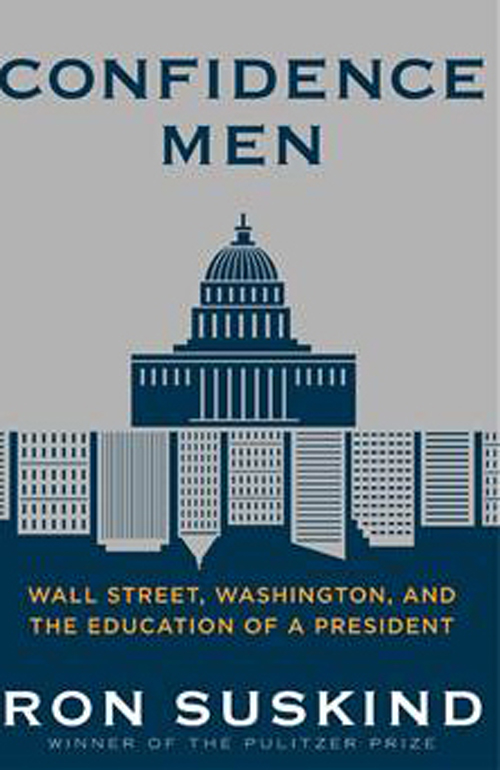 Many in the Chicago Teachers Union are reading Ron Suskind's book "Confidence Men" to learn more about how Barack Obama surrendered and betrayed his history with the Chicago Teachers Union so easily once he was courted by Wall Street during the campaign. Although it is not in "Confidence Men", Obama's history of support from the Chicago Teachers Union leadership is part of the truth he and his handlers have been trying to erase since the summer of 2008. Following his election in 2008. Obama immediately betrayed the unions, then doubled-down on his insults to the unions in general by reneging on "Card Check" for organizing. Then he added insult to injury with the teachers unions by appointing Chicago's Arne Duncan to head the U.S. Department of Education push the privatization agenda and "Race to the Top." Left out of the current versions of the Obama myths are the fact that the Chicago unions — specificially the Chicago Teachers Union — put Obama in the U.S. Senate. Without the grim determination of the leaders of the Chicago Teachers Union, the endorsement for that Senate seat would have gone to a guy named Dan Hynes, who at the time had the backing of most Cook Count Democratic Party leaders, and most of the unions. It was the CTU leadership that dug in its heels, backed Obama fiercely, and turned around first the IFT and then most of the labor leadership. The president and vice president of the CTU were thus responsible for positioning Barack Obama for one of the greatest opportunistic sellouts in recent U.S. political history — the dramatic move from a Main Street reality in order to get elected to a Wall Street mythology once he was elected. Although the unions' history is not in "Confidence Men," the Wall Street part is there in dramatic detail. But back home, memories are still as fresh as the twists in the latest Obama speech. The office that Obama used inside the Chicago Teachers Union offices at Chicago's Merchandise Mart is still in use — and remembered from the days when Obama would walk the union's halls, hang out with the union's leaders and staff, and tell everyone "Call me Barack". Obama's memory became much shorter than the facts once his billionaire and millionaire friends surrounded him with a wall of globalization, Atlas Shrugged catechisms, and "confidence in Wall Street" nonsense. Obama's most recent gift to Chicago's teachers and the union that fought to get him the nomination to the Senate seat — and then walked the streets of every county in the USA to bring out the votes for him — is his union busting millionaire "relationship banker," former White House Chief of Staff Rahm Emanuel. Substance graphic caption written by George N. Schmidt. Let's hope that readers of Substance will note carefully what Roger Lowenstein points out about the history of the New Deal and other reforms aimed at reigning in excessive capitalist greed in the USA before it's too late. It wasn't, historically, the obscure wannabes of wealth — the Bill Clintons, or Barack Obamas — who were able to forge the political alliances and implement the policies, as law, that stopped the worst and most dangerous excesses of monopoly capitalism. It was men like Franklin Roosevelt who understood the system from the inside because they were born to great wealth and had been schooled by those who were comfortable with it. Men like Barack Obama, Rahm Emanuel, and Bill Clinton will always need to "earn" their first $10 million or $100 million before they realize that capitalism is running itself into a wall and move to reform it. Obama is the perfect example of the kind of charismatic political leader who can't be trusted to reign in the Age of Excess and Greed, because he is still looking towards the opportunities he will have, when he leaves the oval office, to do "relationship banking" or other stuff like that and earn his first ten, twenty, or one hundred million.].
Many in the Chicago Teachers Union are reading Ron Suskind's book "Confidence Men" to learn more about how Barack Obama surrendered and betrayed his history with the Chicago Teachers Union so easily once he was courted by Wall Street during the campaign. Although it is not in "Confidence Men", Obama's history of support from the Chicago Teachers Union leadership is part of the truth he and his handlers have been trying to erase since the summer of 2008. Following his election in 2008. Obama immediately betrayed the unions, then doubled-down on his insults to the unions in general by reneging on "Card Check" for organizing. Then he added insult to injury with the teachers unions by appointing Chicago's Arne Duncan to head the U.S. Department of Education push the privatization agenda and "Race to the Top." Left out of the current versions of the Obama myths are the fact that the Chicago unions — specificially the Chicago Teachers Union — put Obama in the U.S. Senate. Without the grim determination of the leaders of the Chicago Teachers Union, the endorsement for that Senate seat would have gone to a guy named Dan Hynes, who at the time had the backing of most Cook Count Democratic Party leaders, and most of the unions. It was the CTU leadership that dug in its heels, backed Obama fiercely, and turned around first the IFT and then most of the labor leadership. The president and vice president of the CTU were thus responsible for positioning Barack Obama for one of the greatest opportunistic sellouts in recent U.S. political history — the dramatic move from a Main Street reality in order to get elected to a Wall Street mythology once he was elected. Although the unions' history is not in "Confidence Men," the Wall Street part is there in dramatic detail. But back home, memories are still as fresh as the twists in the latest Obama speech. The office that Obama used inside the Chicago Teachers Union offices at Chicago's Merchandise Mart is still in use — and remembered from the days when Obama would walk the union's halls, hang out with the union's leaders and staff, and tell everyone "Call me Barack". Obama's memory became much shorter than the facts once his billionaire and millionaire friends surrounded him with a wall of globalization, Atlas Shrugged catechisms, and "confidence in Wall Street" nonsense. Obama's most recent gift to Chicago's teachers and the union that fought to get him the nomination to the Senate seat — and then walked the streets of every county in the USA to bring out the votes for him — is his union busting millionaire "relationship banker," former White House Chief of Staff Rahm Emanuel. Substance graphic caption written by George N. Schmidt. Let's hope that readers of Substance will note carefully what Roger Lowenstein points out about the history of the New Deal and other reforms aimed at reigning in excessive capitalist greed in the USA before it's too late. It wasn't, historically, the obscure wannabes of wealth — the Bill Clintons, or Barack Obamas — who were able to forge the political alliances and implement the policies, as law, that stopped the worst and most dangerous excesses of monopoly capitalism. It was men like Franklin Roosevelt who understood the system from the inside because they were born to great wealth and had been schooled by those who were comfortable with it. Men like Barack Obama, Rahm Emanuel, and Bill Clinton will always need to "earn" their first $10 million or $100 million before they realize that capitalism is running itself into a wall and move to reform it. Obama is the perfect example of the kind of charismatic political leader who can't be trusted to reign in the Age of Excess and Greed, because he is still looking towards the opportunities he will have, when he leaves the oval office, to do "relationship banking" or other stuff like that and earn his first ten, twenty, or one hundred million.].
FIRST BLOOMBERG STORY: WHO HAS DEVELOPED THE CONCEPTUALIZATION OF OCCUPY WALL STREET?
David Graeber, the Anti-Leader of Occupy Wall Street. Meet the anthropologist, activist, and anarchist who helped transform a hapless rally into a global protest movement
By Drake Bennett (Bloomberg Business Week, October 31, 2011)
David Graeber likes to say that he had three goals for the year: promote his book, learn to drive, and launch a worldwide revolution. The first is going well, the second has proven challenging, and the third is looking up.
Graeber is a 50-year-old anthropologist—among the brightest, some argue, of his generation—who made his name with innovative theories on exchange and value, exploring phenomena such as Iroquois wampum and the Kwakiutl potlatch. An American, he teaches at Goldsmiths, University of London. He’s also an anarchist and radical organizer, a veteran of many of the major left-wing demonstrations of the past decade: Quebec City and Genoa, the Republican National Convention protests in Philadelphia and New York, the World Economic Forum in New York in 2002, the London tuition protests earlier this year. This summer, Graeber was a key member of a small band of activists who quietly planned, then noisily carried out, the occupation of Lower Manhattan’s Zuccotti Park, providing the focal point for what has grown into an amorphous global movement known as Occupy Wall Street.
It would be wrong to call Graeber a leader of the protesters, since their insistently nonhierarchical philosophy makes such a concept heretical. Nor is he a spokesman, since they have refused thus far to outline specific demands. Even in Zuccotti Park, his name isn’t widely known. But he has been one of the group’s most articulate voices, able to frame the movement’s welter of hopes and grievances within a deeper critique of the historical moment. “We are watching the beginnings of the defiant self-assertion of a new generation of Americans, a generation who are looking forward to finishing their education with no jobs, no future, but still saddled with enormous and unforgivable debt,” Graeber wrote in a Sept. 25 editorial published online by the Guardian. “Is it really surprising they would like to have a word with the financial magnates who stole their future?”
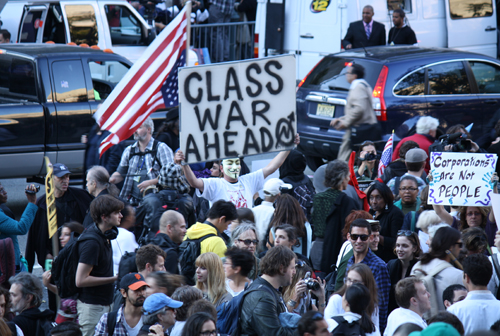 The Guy Fawkes masks that some "Occupy" protesters are sporting has unnerved some on Wall Street and in London's City. Above, a couple of signs and a symbol during the October 7 marches and rally in New York City. Substance photo by John Lawhead.Graeber’s politics have been shaped by his experience in global justice protests over the years, but they are also fed by the other half of his life: his work as an anthropologist. Graeber’s latest book, published two months before the start of Occupy Wall Street, is entitled Debt: The First 5,000 Years. It is an alternate history of the rise of money and markets, a sprawling, erudite, provocative work. Looking at societies ranging from the West African Tiv people and ancient Sumer to Medieval Ireland and modern-day America, he explores the ambivalent attitudes people have always had about debt: as obligation and sin, engine of economic growth and tool of oppression. Along the way, he tries to answer questions such as why so many people over the course of history have simultaneously believed that it is a matter of morality to repay debts and that those who lend money for a living are evil.
The Guy Fawkes masks that some "Occupy" protesters are sporting has unnerved some on Wall Street and in London's City. Above, a couple of signs and a symbol during the October 7 marches and rally in New York City. Substance photo by John Lawhead.Graeber’s politics have been shaped by his experience in global justice protests over the years, but they are also fed by the other half of his life: his work as an anthropologist. Graeber’s latest book, published two months before the start of Occupy Wall Street, is entitled Debt: The First 5,000 Years. It is an alternate history of the rise of money and markets, a sprawling, erudite, provocative work. Looking at societies ranging from the West African Tiv people and ancient Sumer to Medieval Ireland and modern-day America, he explores the ambivalent attitudes people have always had about debt: as obligation and sin, engine of economic growth and tool of oppression. Along the way, he tries to answer questions such as why so many people over the course of history have simultaneously believed that it is a matter of morality to repay debts and that those who lend money for a living are evil.
Graeber’s arguments place him squarely at odds with mainstream economic thought, and the discipline has, for the most part, ignored him. But his timing couldn’t be better to reach a popular audience. His writing provides an intellectual frame and a sort of genealogy for the movement he helped start. The inchoate anger of the Occupy Wall Street protesters tends to cluster around two things. One is the influence of money in politics. The other is debt: mortgages, credit-card debt, student loans, and the difference in how the debts of large financial companies and those of individual borrowers have been treated in the wake of the 2008 financial crisis.
“He is a deep thinker. He’s been a student of movements and revolutions,” says Kalle Lasn, the founder of Adbusters, the Vancouver-based anticorporate magazine. “He’s the sort of guy who can say, ‘Is this thing we’re going through like 1968 or is it like the French Revolution?’ ”
As Graeber explains it, it’s all part of a larger story: Throughout history, debt has served as a way for states to control their subjects and extract resources from them (usually to finance wars). And when enough people got in enough debt, there was usually some kind of revolt.
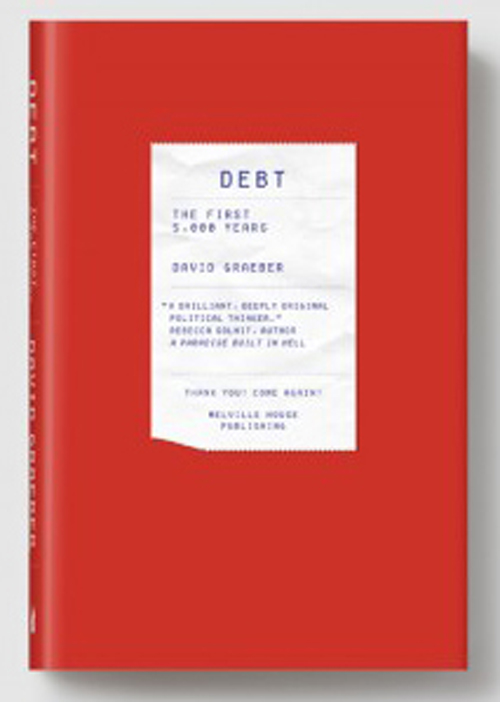 The book "Debt: The First 5,000 Years" is also being studied in Chicago among researchers at the Chicago Teachers Union. Occupy Wall Street and Occupy Chicago have joined Stand Up Chicago and Take Back Chicago — mass mobilizations already in progress — as the former White House Chief of Staff Rahm Emanuel, backed by the city's millionaires and billionaires, works to destroy the unions of public workers — or return them to their lapdog status as company unions (which the Chicago Teachers Union had become under the leadership of the United Progressive Caucus during the 1990s and most of the 21st Century to date). Graeber is small-framed and fidgety, with a pale boyish face and blue eyes. He dresses like a graduate student and speaks fast, in bursts punctuated by long ums, a ragged laugh, or pauses to catch his breath. He doesn’t make much eye contact. When finishing a thought, he has a habit of ducking his head and arching his eyebrows, as if he has just heard a faint but alarming sound.
The book "Debt: The First 5,000 Years" is also being studied in Chicago among researchers at the Chicago Teachers Union. Occupy Wall Street and Occupy Chicago have joined Stand Up Chicago and Take Back Chicago — mass mobilizations already in progress — as the former White House Chief of Staff Rahm Emanuel, backed by the city's millionaires and billionaires, works to destroy the unions of public workers — or return them to their lapdog status as company unions (which the Chicago Teachers Union had become under the leadership of the United Progressive Caucus during the 1990s and most of the 21st Century to date). Graeber is small-framed and fidgety, with a pale boyish face and blue eyes. He dresses like a graduate student and speaks fast, in bursts punctuated by long ums, a ragged laugh, or pauses to catch his breath. He doesn’t make much eye contact. When finishing a thought, he has a habit of ducking his head and arching his eyebrows, as if he has just heard a faint but alarming sound.
For several weeks—since the fourth day of Occupy Wall Street—Graeber has been in Austin, Tex., reuniting with his girlfriend, a fellow anthropologist just back from fieldwork in Mexico. While there he has been peripherally involved with Occupy Austin, a small, fractious offshoot of the original Zuccotti Park occupation, one of many around the world.
Graeber began the summer on sabbatical, moving back to New York from London and frequenting an artists’ space called 16Beaver. It was an intellectual activist salon, located near Wall Street, the sort of place where people would discuss topics like semiotics and hacking and the struggles of indigenous peoples. Like many other American activists, Graeber had been deeply moved by the occupation of Cairo’s Tahrir Square and by the “Indignados” who had taken over central Madrid; in mid-July, he published a short piece in Adbusters asking what it would take to trigger a similar uprising in the West. For much of the summer, the discussions at 16Beaver revolved around exactly that question. When a local group called Operation Empire State Rebellion called for a June 14 occupation of Zuccotti Park, four people showed up.
On July 13, Adbusters put out its own call for a Wall Street occupation, to take place two months later, on Sept. 17. Setting the date and publicizing it was the extent of the magazine’s involvement. A group called New Yorkers Against Budget Cuts—student activists and community leaders from some of the city’s poorer neighborhoods—stepped in to execute the rest. For three weeks in June and July, to protest city budget cuts and layoffs, the group had camped out across the street from City Hall in a tent city they called Bloombergville. They liked the idea of trying a similar approach on Wall Street. After talking to Adbusters, the group began advertising a “People’s General Assembly” to “Oppose Cutbacks And Austerity Of Any Kind” and plan the Sept. 17 occupation.
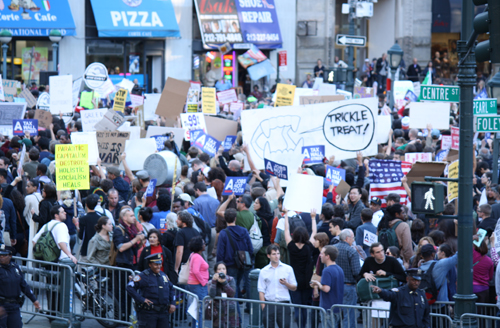 History still remembers that Foley Square was the location of the anti-Communist trials of the 1950s, even as the corner is reborn in a new way thanks to Occupy Wall Street and the joining of the unions and the new protest mobilizations. Substance photo October 7, 2011, by John Lawhead.The assembly was to be held in Bowling Green, the downtown Manhattan park with its famous statue of a charging bull pawing the cobblestones. Graeber had heard about the meeting at 16Beaver, and the afternoon of Aug. 2 he went to Bowling Green with two friends, a Greek artist and anarchist named Georgia Sagri and a Japanese activist named Sabu Kohso (who is also the Japanese translator of Graeber’s books).
History still remembers that Foley Square was the location of the anti-Communist trials of the 1950s, even as the corner is reborn in a new way thanks to Occupy Wall Street and the joining of the unions and the new protest mobilizations. Substance photo October 7, 2011, by John Lawhead.The assembly was to be held in Bowling Green, the downtown Manhattan park with its famous statue of a charging bull pawing the cobblestones. Graeber had heard about the meeting at 16Beaver, and the afternoon of Aug. 2 he went to Bowling Green with two friends, a Greek artist and anarchist named Georgia Sagri and a Japanese activist named Sabu Kohso (who is also the Japanese translator of Graeber’s books).
A “general assembly” means something specific and special to an anarchist. In a way, it’s the central concept of contemporary anarchist activism, which is premised on the idea that revolutionary movements relying on coercion of any kind only result in repressive societies. A “GA” is a carefully facilitated group discussion through which decisions are made—not by a few leaders, or even by majority rule, but by consensus. Unresolved questions are referred to working groups within the assembly, but eventually everyone has to agree, even in assemblies that swell into the thousands. It can be an arduous process. One of the things Occupy Wall Street has done is introduce the GA to a wider audience, along with the distinctive sign language participants use to raise questions or express support, disapproval, or outright opposition.
When Graeber and his friends showed up on Aug. 2, however, they found out that the event wasn’t, in fact, a general assembly, but a traditional rally, to be followed by a short meeting and a march to Wall Street to deliver a set of predetermined demands (“A massive public-private jobs program” was one, “An end to oppression and war!” was another). In anarchist argot, the event was being run by “verticals”—top-down organizations—rather than “horizontals” such as Graeber and his friends. Sagri and Graeber felt they’d been had, and they were angry.
What happened next sounds like an anarchist parable. Along with Kohso, the two recruited several other people disgruntled with the proceedings, then walked to the south end of the park and began to hold their own GA, getting down to the business of planning the Sept. 17 occupation. The original dozen or so people gradually swelled, despite the efforts of the event’s planners to bring them back to the rally. The tug of war lasted until late in the evening, but eventually all of the 50 or so people remaining at Bowling Green had joined the insurgent general assembly.
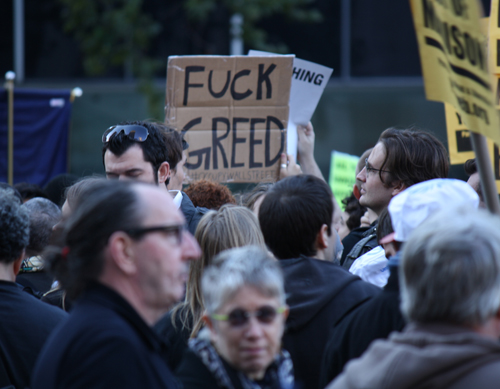 Some of the political, cultural, and economic messages of Occupy Wall Street have been more direct than others. Substance photo October 7, 2011, by John Lawhead.“The groups that were organizing the rally, they also came along,” recalls Kohso. “Then everyone stayed very, very late to organize what committees we needed.”
Some of the political, cultural, and economic messages of Occupy Wall Street have been more direct than others. Substance photo October 7, 2011, by John Lawhead.“The groups that were organizing the rally, they also came along,” recalls Kohso. “Then everyone stayed very, very late to organize what committees we needed.”
While there were weeks of planning yet to go, the important battle had been won. The show would be run by horizontals, and the choices that would follow—the decision not to have leaders or even designated police liaisons, the daily GAs and myriad working-group meetings that still form the heart of the protests in Zuccotti Park—all flowed from that.
For Graeber the next month and a half was a carousel of meetings. There were the weekly GAs, the first held near the Irish Hunger Memorial in Battery Park City, the rest in Tompkins Square Park in the East Village. He facilitated some of them and spent much of the rest of his time in working group meetings in people’s apartments. (On Aug. 14 he tweeted, “I am so exhausted. My first driving lesson … then had to facilitate an assembly in Tompkins Square Park for like three hours.”) He organized legal and medical training and classes on nonviolent resistance. The group endlessly discussed what demands to make, or whether to have demands at all—a question that months later remains unresolved.
In the Sept. 10 general assembly the group picked the target for their occupation: One Chase Manhattan Plaza. They also picked several backups. So when the police fenced off Chase Plaza the night before the occupation was scheduled to start, the occupiers were prepared. On Sept. 17, barely an hour before the scheduled 3 p.m. start time, the word went out to go to Zuccotti Park instead, and 2,000 people converged on the now famous patch of stone flooring, low benches, and trees.
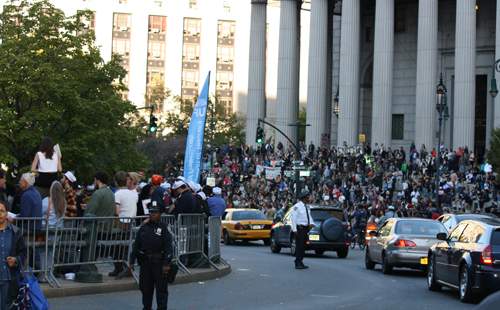 The two-storey high United Federation of Teachers banner stands at the center of one crowd of protesters on October 7 during one of the Occupy Wall Street actions. The UFT, Local 2 of the American Federation of Teachers, has been growing more critical of the union's national leadership (under former UFT President Randi Weingarten) as economic and political events have moved of late. Substance photo October 7, 2011, by John Lawhead.It was a fortunate choice: Zuccotti is a privately owned park, so the city doesn’t have the right to remove the protesters. Graeber helped facilitate the GA that night in which they decided to camp out in the park rather than immediately march on Wall Street. Three days later, when he flew to Austin, the protests were still little more than a local New York story.
The two-storey high United Federation of Teachers banner stands at the center of one crowd of protesters on October 7 during one of the Occupy Wall Street actions. The UFT, Local 2 of the American Federation of Teachers, has been growing more critical of the union's national leadership (under former UFT President Randi Weingarten) as economic and political events have moved of late. Substance photo October 7, 2011, by John Lawhead.It was a fortunate choice: Zuccotti is a privately owned park, so the city doesn’t have the right to remove the protesters. Graeber helped facilitate the GA that night in which they decided to camp out in the park rather than immediately march on Wall Street. Three days later, when he flew to Austin, the protests were still little more than a local New York story.
Graeber has been an anarchist since the age of 16. He grew up in New York, in a trade-union-sponsored cooperative apartment building in Chelsea suffused with radical politics. A precocious child, he became obsessed at 11 with Mayan hieroglyphics. (The writing had then been only partially deciphered.) He sent some of his original translations to a leading scholar in the field, who was so impressed that he arranged for Graeber to get a scholarship to Phillips Academy in Andover, Mass.
Graeber’s parents were in their 40s when they had him and had come of age in the political left of the 1930s, self-taught working-class intellectuals. Graeber’s mother had been a garment worker and, briefly, a celebrity—the female lead in a musical comedy revue put on by the International Ladies’ Garment Workers’ Union that managed to become a Broadway hit. His father worked as a plate stripper on offset printers. Originally from Kansas, he had fought for the Republicans in the Spanish Civil War. Anarchists made up one part of the fragile Republican coalition, and for a brief period they controlled Barcelona.
“Most people don’t think anarchism is a bad idea. They think it’s insane,” says Graeber. “Yeah, sure it would be great not to have prisons and police and hierarchical structures of authority, but everybody would just start killing each other. That wouldn’t work, right?” Graeber’s father, however, had seen it work. “So it wasn’t insane. I was never brought up to think it was insane.”
Years later, Graeber was a graduate student at the University of Chicago, and his field research brought him into contact with another, albeit very different, anarchic community. His dissertation was on Betafo, a rural community in Madagascar made up of the descendants of nobles and their slaves.
Because of spending cuts mandated by the International Monetary Fund—the sort of structural-adjustment policies Graeber would later protest—the central government had abandoned the area, leaving the inhabitants to fend for themselves. They did, creating an egalitarian society where 10,000 people made decisions more or less by consensus. When necessary, criminal justice was carried out by a mob, but even there a particular sort of consensus pertained: a lynching required permission from the accused’s parents.
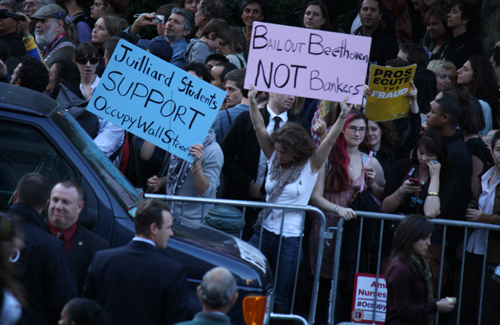 The ruthless cuts in the arts for working class people have reminded some historians of the days when beauty in art, music and other expressions was the exclusive preserve of the aristocracy and and many artists were in fact indentured servants of the rich and powerful. As debt peonage increasingly forces artists to choose between further education and other dreams, the expressions will develop in new and unknown ways. Substance photo October 7, 2011, by John Lawhead. Graeber didn’t become an activist until after the massive 1999 World Trade Organization protests in Seattle. At the time an associate professor at Yale, he realized that the sort of movement he had always wanted to join had come into being while he was concentrating on his academic career. “If you’re really dedicated to this stuff, things can happen very quickly,” he says. “The first action you go to, you’re just a total outsider. You don’t know what’s going on. The second one, you know everything. By the third, you’re effectively part of the leadership if you want to be. Anybody can be if you’re willing to put in the time and energy.”
The ruthless cuts in the arts for working class people have reminded some historians of the days when beauty in art, music and other expressions was the exclusive preserve of the aristocracy and and many artists were in fact indentured servants of the rich and powerful. As debt peonage increasingly forces artists to choose between further education and other dreams, the expressions will develop in new and unknown ways. Substance photo October 7, 2011, by John Lawhead. Graeber didn’t become an activist until after the massive 1999 World Trade Organization protests in Seattle. At the time an associate professor at Yale, he realized that the sort of movement he had always wanted to join had come into being while he was concentrating on his academic career. “If you’re really dedicated to this stuff, things can happen very quickly,” he says. “The first action you go to, you’re just a total outsider. You don’t know what’s going on. The second one, you know everything. By the third, you’re effectively part of the leadership if you want to be. Anybody can be if you’re willing to put in the time and energy.”
It was a particularly happy period for Graeber. In New Haven he was a scholar, and in New York, where he spent much of his time, he was an anarchist—he had found a new community among the loose coalition of activists, artists, and pranksters who called themselves the Direct Action Network. There were protests but also elaborately choreographed festivities—“reclaim the streets” parties, or nights when everyone converged on a particular subway train and rode it through the city carousing.
It came to an end in 2005, when Yale terminated his contract before he had a chance to come up for tenure. Graeber appealed, and his case became a cause at Yale and in the broader community of academic anthropology. He maintains he was targeted at least in part because of his political activism. Others saw evidence that the modern university was exactly the sort of hierarchical organization that Graeber was philosophically opposed to and temperamentally unsuited for.
“There was an issue about his personal style, whether he was respectful enough to various senior people both in the department and at the university. He’s not someone who is known to be very pliable,” recalls Thomas Blom Hansen, an anthropology professor at Stanford who was a friend and Yale colleague of Graeber’s at the time. “I don’t think anyone doubts that he’s a major figure in his field,” he adds. “But he’s not really interested in the humdrum daily life of administration that constitutes an increasing part of our life in the academic world.”
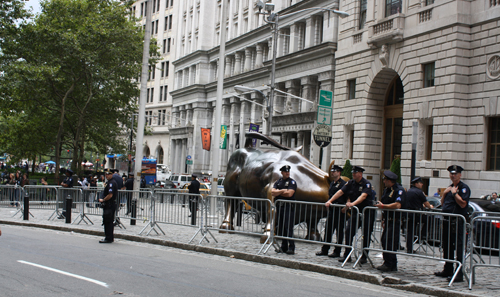 In a scene that resembles "Where's Waldo?" Substance readers have been challenged to count how many New York City police officers were assigned to guard the Wall Street Bull on October 7, 2011. Clearly, the dozen officers that can be seen in the above photograph were pulling dangerous duty, while vast areas of Brooklyn, Queens, and the Bronx were left with less than adequate police services. Who decided that the Bull deserved more protection than hundreds of thousands of people in New York's boroughs? Substance photo October 7, 2011, by John Lawhead.Everyone involved in the creation of Occupy Wall Street, from Graeber to the editors of Adbusters to New Yorkers Against Budget Cuts, has been astonished by its success. The world of American left-wing activism, populated as it is by an unwieldy mix of progressives and pacifists, civil libertarians and Marxists, idealists and pragmatists, is often riven by disputes and mutual misunderstanding. What’s notable about Occupy Wall Street is that it was born not in spite of that tendency but because of it. For his part, Graeber doesn’t attribute the success of the occupation to its planners but to luck, timing, and the pervasive mood of anger and disillusionment in the country: There are few jobs, the political process has ground to a halt, and as individuals and as a nation, we’re drowning in debt.
In a scene that resembles "Where's Waldo?" Substance readers have been challenged to count how many New York City police officers were assigned to guard the Wall Street Bull on October 7, 2011. Clearly, the dozen officers that can be seen in the above photograph were pulling dangerous duty, while vast areas of Brooklyn, Queens, and the Bronx were left with less than adequate police services. Who decided that the Bull deserved more protection than hundreds of thousands of people in New York's boroughs? Substance photo October 7, 2011, by John Lawhead.Everyone involved in the creation of Occupy Wall Street, from Graeber to the editors of Adbusters to New Yorkers Against Budget Cuts, has been astonished by its success. The world of American left-wing activism, populated as it is by an unwieldy mix of progressives and pacifists, civil libertarians and Marxists, idealists and pragmatists, is often riven by disputes and mutual misunderstanding. What’s notable about Occupy Wall Street is that it was born not in spite of that tendency but because of it. For his part, Graeber doesn’t attribute the success of the occupation to its planners but to luck, timing, and the pervasive mood of anger and disillusionment in the country: There are few jobs, the political process has ground to a halt, and as individuals and as a nation, we’re drowning in debt.
Graeber’s problem with debt is not just that having too much of it is bad. More fundamental, he writes in his book, is debt’s perversion of the natural instinct for humans to help each other. Economics textbooks tell a story in which money and markets arise out of the human tendency to “truck and barter,” as Adam Smith put it. Before there was money, Smith argued, people would trade seven chickens for a goat, or a bag of grain for a pair of sandals. Then some enterprising merchant realized it would be easier to just price all of them in a common medium of exchange, like silver or wampum. The problem with this story, anthropologists have been arguing for decades, is that it doesn’t seem ever to have happened. “No example of a barter economy, pure and simple, has ever been described, let alone the emergence from it of money,” writes anthropologist Caroline Humphrey, in a passage Graeber quotes.
People in societies without money don’t barter, not unless they’re dealing with a total stranger or an enemy. Instead they give things to each other, sometimes as a form of tribute, sometimes to get something later in return, and sometimes as an outright gift. Money, therefore, wasn’t created by traders trying to make it easier to barter, it was created by states like ancient Egypt or massive temple bureaucracies in Sumer so that people had a more efficient way of paying taxes, or simply to measure property holdings. In the process, they introduced the concept of price and of an impersonal market, and that ate away at all those organic webs of mutual support that had existed before.
That’s ancient history, literally. So why does it matter? Because money, Graeber argues, turns obligations and responsibilities, which are social things, into debt, which is purely financial. The sense we have that it’s important to repay debts corrupts the impulse to take care of each other: Debts are not sacred, human relationships are.
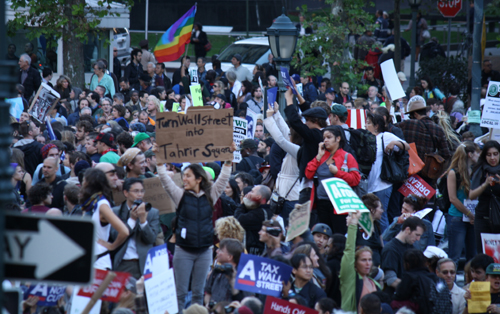 The Arab Spring was being turned into the American Autumn as Occupy Wall Street joined with the largest unions in the USA on October 7, 2011, in New York City. Substance photo October 7, 2011, by John Lawhead.If we understand the social origins of debt, Graeber says, we become much more willing to renegotiate debts when conditions change, whether those are mortgages, credit-card debts, student loans, or the debts of entire nations. And if the desperate response to the ongoing financial crisis has shown anything, he argues, it’s that we’re willing to forgive debts if the institution that has them is important.
The Arab Spring was being turned into the American Autumn as Occupy Wall Street joined with the largest unions in the USA on October 7, 2011, in New York City. Substance photo October 7, 2011, by John Lawhead.If we understand the social origins of debt, Graeber says, we become much more willing to renegotiate debts when conditions change, whether those are mortgages, credit-card debts, student loans, or the debts of entire nations. And if the desperate response to the ongoing financial crisis has shown anything, he argues, it’s that we’re willing to forgive debts if the institution that has them is important.
“Sovereignty does ultimately belong to the people, at least in theory. You gave the bank the right to make up money that is then lent to you,” he argues. “We collectively create this stuff, and so we could do it differently.”
Graeber’s book is getting glowing praise from his fellow anthropologists, and it has gotten attention beyond that world as well. (Though according to Mandy Henk, a librarian from Indiana minding the library that has sprung up in Zuccotti Park, copies of his work there aren’t seeing a lot of use.) Few mainstream economists are familiar with his ideas. Professor Tyler Cowen of George Mason University, who happens to be a widely read blogger, is one of them. “He whacks a bit of sense into people, and I think he’s right and Adam Smith was wrong,” he says. Yet Cowen, himself a libertarian, isn’t won over to Graeber’s politics. He sees little alternative to the modern state. “Look at Somalia. If there’s a vacuum, something has to fill it.”
He might also point to the drummers of Zuccotti Park. The constant beat from drum circles there has provided the occupation’s soundtrack, but it has also elicited a steady flow of noise complaints, trying the patience of an otherwise supportive community board and elected officials. Through weeks of mediation and discussion in the general assembly, a few drummers have steadfastly defied any limits on when they can play, though organizers are hopeful an agreement hashed out on Oct. 25 will finally solve the problem.
At the end of his book, Graeber does make one policy recommendation: a Biblical-style “jubilee,” a forgiveness of all international and consumer debt. Jubilees are rare in the modern world, but in ancient Babylon, Assyria, and Egypt under the Ptolemies they were a regular occurrence. The alternative, rulers learned, was rioting and chaos in years when poor crop yields left lots of peasants in debt. The very first use in a political document of the word freedom was in a Sumerian king’s debt-cancellation edict. “It would be salutary,” Graeber writes, “not just because it would relieve so much genuine human suffering, but also because it would be our way of reminding ourselves that money is not ineffable, that paying one’s debts is not the essence of morality, that all these things are human arrangements and that if democracy is to mean anything it is the ability to all agree to arrange things in a different way.”
[Bloomberg News —With reporting by Karen Weise. Bennett is a staff writer for Bloomberg Businessweek.]
HISTORICAL ANALYSIS AND WARNING TO RULING CLASS ABOUT THE POTENTIAL OF OCCUPY WALL STREET BECAUSE OF THE INVOLVEMENT OF THE UNIONS
Occupy Wall Street: It’s Not a Hippie Thing. Don’t be fooled by the drum circles. Today’s protests have more in common with the anti-Hoover 1930s than the antiwar ’60s and ’70s. By Roger Lowenstein (Bloomberg Business Week, October 31, 2011)
Two photos appear with the story in the print edition: The 1970 Hard Hat Riot saw construction workers disrupting protesters with a pro-war rally of their own; a protester in Rome cheers a police van going up in flames on Oct. 15 Left to Right: Frank Castoral/NY Daily News via Getty Images; Giorgiio Cosulich/Getty Images
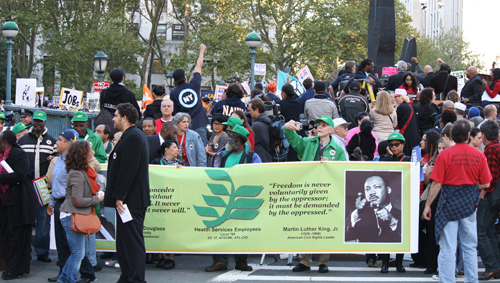 By October 7, New York's labor unions had joined "Occupy Wall Street." Above, the hospital workers' union banner during one of the demonstrations. Substance photo by John Lawhead.For all its social snootiness, Wall Street has suffered far more from the meddling of members of its own class than from intrusions by those outside it. It was Franklin D. Roosevelt, an aristocrat, who held the lords of finance responsible for the Great Depression—securing legislation to establish the Securities and Exchange Commission, asserting federal authority over the stock exchange, and appointing a wealthy stock trader, Joseph Kennedy Sr., to ride herd. Not much better, from Wall Street’s perspective, was FDR’s Cousin Teddy, who as President prosecuted trusts as illegal monopolies. Or Louis Brandeis, a Harvard-trained corporate attorney turned crusader against the concentration of wealth and power.
By October 7, New York's labor unions had joined "Occupy Wall Street." Above, the hospital workers' union banner during one of the demonstrations. Substance photo by John Lawhead.For all its social snootiness, Wall Street has suffered far more from the meddling of members of its own class than from intrusions by those outside it. It was Franklin D. Roosevelt, an aristocrat, who held the lords of finance responsible for the Great Depression—securing legislation to establish the Securities and Exchange Commission, asserting federal authority over the stock exchange, and appointing a wealthy stock trader, Joseph Kennedy Sr., to ride herd. Not much better, from Wall Street’s perspective, was FDR’s Cousin Teddy, who as President prosecuted trusts as illegal monopolies. Or Louis Brandeis, a Harvard-trained corporate attorney turned crusader against the concentration of wealth and power.
These men changed the system from within, as have the ablest regulators in recent times. Arthur Levitt Jr., a vigorous SEC chairman under President Bill Clinton, was first the president of Shearson Hayden Stone. (Levitt is a member of the board of Bloomberg L.P., owner of Bloomberg Businessweek.) Paul A. Volcker cut his teeth at Chase Manhattan before running the Federal Reserve and becoming the gruff animating voice behind the Volcker Rule, which bans commercial banks from engaging in proprietary trading. It’s hard to imagine any of these “opponents” of Wall Street mounting a barricade. They didn’t need to storm the castle to know where the secrets were hidden.
In its very amateurism, Occupy Wall Street represents something new. Although it’s attracted some celebrities and well-heeled supporters, participants come chiefly from outside Wall Street. Many are unemployed or poorly employed. These are not bankers or reform-minded professors; these are also-rans in the capitalist race, upset with the system itself. Their chief weapon is neither eloquence nor argument, but their physical presence.
As critics have noted, the protesters are not in complete agreement with each other, but the overall message is reasonably coherent. They want more and better jobs, more equal distribution of income, less profit (or no profit) for banks, lower compensation for bankers, and more strictures on banks with regard to negotiating consumer services such as mortgages and debit cards. They also want to reduce the influence that corporations—financial firms in particular—wield in politics, and they want a more populist set of government priorities: bailouts for student debtors and mortgage holders, not just for banks.
In its grassroots and leftist character, Occupy Wall Street bears a superficial resemblance to protests from the ’60s and early ’70s. But the Woodstock Era was different in ways that tell us important things about the current siege. Then, radical students preached an affinity with the “working class,” but it was rare that the students and any members of the working class actually joined arms.
Consider the morning of May 8, 1970, when 1,000 young people, mostly students, converged on the New York Stock Exchange (NYX) to demonstrate against the killing four days earlier of four antiwar protesters at Kent State University in Ohio. I’d been at many such affairs (though not this one) in which “capitalism” and “corporations” were casually excoriated. Socialism, to many of my peers, was appealing; making a profit was not.
On that morning, the protesters demanded an end to the war and a cessation of military research on university campuses. Several hours into the demonstration, about 200 construction workers—wearing their hard hats for emphasis—began a counter, pro-war demonstration organized by Peter J. Brennan, president of the Building and Construction Trades Council of Greater New York. Around noon, the hard hats broke through a thin line of police, charged the students, and beat up scores of long-hairs, 70 of whom were hospitalized. Several Wall Street bankers and lawyers, in an apparent gesture of solidarity—the kids, after all, could have been their kids—tried to shelter protesters and were themselves beaten. Only six people were arrested.
The Hard Hat Riot epitomized the battle lines of the era: protesters and workers on opposite sides. The former didn’t empathize with workers because the latter were judged to be pro-war, pro-Establishment, pro-U.S. government. And factory workers had little use for Janis Joplin or free love. The movement wasted little effort on corporate villains—and none on banks. The enemy was the government, the Defense Dept., and the select corporate contractors who did its bidding, such as Dow Chemical (DOW).
White suburban protesters were free to indulge their indignation because they were largely unperturbed by financial issues. Most were affluent, or at least middle-class, and upward mobility was a birthright. People feared the cops, the draft, authority figures in general—we didn’t fear unemployment. At 16 my peers and I discussed politics always; the stock market never. Young people expressed solidarity with nonunion minority workers such as migrant farm workers because theirs was a political struggle as much as an economic one. There was no solidarity with the teamsters.
Although neither side would have believed it then, it’s the hard hats who were the forefathers of today’s protesters. They were the vulnerable ones, and the next few decades would prove just how endangered their livelihoods would become.
Economically, the U.S. is a different country than it was in 1970—and it will remain so regardless of how long the Occupy Wall Street protests endure. In the America of the early postwar decades, economic progress and a plenitude of jobs were axiomatic. Today they are not. Then, blue-collar jobs in steel, autos, machinery, and similar industries lifted families into the middle class; today, new workers at General Motors (GM) are hired at $29,000 a year, and even people with college degrees are hurting. Median household income, adjusted for inflation, is no higher today than it was in 1989. During the just-ended economic cycle (ending before the bust), median income actually fell. Capitalism may have triumphed in China—even in Vietnam—but in America it’s in a quagmire. This is what has brought the protesters to Wall Street.
Zuccotti Park sits in the shadow of One Liberty Plaza, a soaring black skyscraper that’s home to Nasdaq (NDAQ), Goldman Sachs (GS), and other financial tenants. In the ’80s, I used to play chess in the park with a dark-suited employee of Merrill Lynch who, when advancing one of the small pieces in the second row, would knowingly proclaim, “Pawns are people too.” Today, it’s the people who are pawns—or such is the rhetoric in Zuccotti Park. Merrill, then, was the people’s broker; today, as a result of its reckless speculation in mortgage securities, Merrill is a ward of Bank of America (BAC), which is staggering under the weight of its own mortgage miscues and is cited as a villain by many of those who are occupying Wall Street.
Although jammed with tarps, tents, a “mobile library” consisting of hundreds of books in plastic bins, the inevitable food station, and hundreds of people, Zuccotti Park has a similar feel to Speakers’ Corner, the open-air site for public orations in London’s Hyde Park. The run of opinions ranges from informed and specific—one morning a man in his 20s, recently laid off from teaching at a charter school, was holding forth against the tax break for “carried interest”—to rambling and unsophisticated. “It’s unfair how investment banks can print money and use it for what they want,” said Ryan Vener, before correcting himself and substituting the Fed for banks. Stan Rogouski, outfitted in a red and black lumber jacket, held a sign saying, “America Be No. 1 Again by Getting Rid of the 1%.” Rogouski said he hoped to put the corporate media, including me, out of a job.
Far from battling unions, Occupy Wall Street has their active support. David Martinez, a shop steward for Teamsters Local 814, has been shuttling between Zuccotti Park and Sotheby’s (BID), the Upper East Side auction house that’s in a labor dispute with its art handlers. Martinez, in a green Jets cap, says the workers have been locked out and replaced by temporary staff since their contract expired in July. According to the union, Sotheby’s has offered 1 percent annual increases on the hourly wage, increased health-care premiums (which will match rising benefit costs), and continued contributions to the 401(k) program, but wants to cut back on hours, tighten overtime, and gain flexibility to hire nonunion workers. “The most evil part is that they want future workers to be temporary, not union,” Martinez says. Sotheby’s spokesperson Diana Phillips says, “We offered a fair contract with wage increases in every year. We very much want our union colleagues to come back to work.”
Martinez, the son of a fireman, will turn 50 in November. He graduated from Pomona College, an elite school in Southern California, got a master’s in religious studies from Yale, and started work on a PhD. He dreamed of being an artist while teaching religious studies; the closest he came was handling art for Sotheby’s, and now even that job is on the ropes. Martinez was vague about why his career plan didn’t work out, but he’s still a serviceable metaphor for the downward path of the country’s economy: fireman’s son to Yale University to “locked out,” all in one generation.
Martinez’s cohorts in the park speak a dialect (or dialectic) unrecognizable to the financiers who work in the neighborhood. Capitalism teaches that personal ambition is a social good; it does the work of the invisible hand, achieving gains for the one and growth for society. People in the park do not believe this. They have not seen the gains, and they do not think the top 1 percent should earn a fifth or so of the total income while others go without. They resent that corporations are organized for profit; indeed, they see “profits” not as the return on capital invested well, but as evidence that companies are overcharging their customers. At an emotional level they nostalgically yearn for a less “financialized” country—one in which markets are more regulated and with fewer opportunities for speculating on financial assets. Most bankers—probably even most people who regulate banks—think it’s good for the economy that banks have the ability to package mortgages into securities and trade them. The protesters do not.
To the extent that the movement offers remedies, most are unresponsive to the problems that inspired it. Wall Street suffers from two essential flaws. Most obvious is compensation: It’s simply too high. Not only does that create a sense of injustice, it incentivizes recklessness. (A related issue is that bankers are systemically unaccountable. Most firms are public, thus the risk-takers tend to lose neither compensation nor capital when risks go bad.) Secondly, the Street is increasingly indistinguishable from a casino. There’s far too much trading—a zero-sum game that rewards only traders and renders markets more volatile. And some trading, including in many derivative products, serves no economic purpose.
Those problems could be addressed by regulation—for instance, a Tobin-type tax on financial transactions, especially short-term trades. And to some extent, unnoticed on the barricades, they are being addressed. Dodd-Frank has raised the requirements for bank capital, thereby diminishing risk. The Volcker Rule will limit trading. Compensation hasn’t been fixed, nor has the perception that the government, if need be, will bail out banks. Still, bank trading is down, bank risk-taking is down, and profits are down. This is not a happy time for banks.
This should please the protesters, but reforming the 1 percent will do little to fix what ails the 99 percent. High bonuses aren’t the cause of poor job growth or of steadily flattening wages. What contributes most to income disparity in the bottom and the middle of the scale are technology and globalization. People in San Diego and New Delhi now compete in the same labor market, and the connectivity created by high tech means that more Americans—even educated Americans—work in jobs that can be shipped overseas. According to research conducted by Matthew Slaughter, an economist at the Tuck School of Business at Dartmouth, incomes are falling even for people with college degrees. David Martinez has one of the few jobs that cannot be outsourced (handling art), but he’s competing in a labor market in which millions of other people are vulnerable—and Sotheby’s knows it.
Globalization and technology do boost incomes at the upper end, since each allows economic winners to reach a wider market. But these gains are fairly earned. If Amazon.com (AMZN) is able to sell books in China—and the Chinese can sell computers in the U.S.—it’s unclear how, or why, the government should try to stop it. This is the great dilemma of the 99 percent.
The easy political responses—starting a trade war with China, or rounding up all the people who might be undocumented immigrants—won’t accomplish anything. Improving the educational system, investing in infrastructure, and incentivizing corporate investment would, but such steps will take decades, not weeks. If Occupy Wall Street plans on hanging in for real change, the protesters will need to start trading in their tents for drywall.
There are now protests flourishing around the country, including my hometown. Occupy Boston is at the foot of the financial district in Dewey Square, which is given over to scores of closely packed, brightly colored camping tents. On the same day I toured the site, Ben S. Bernanke visited the Federal Reserve Bank of Boston, right across the street, though no one on the square seemed to know it. Nor did Bernanke wander over.
The message in Boston is the same as in New York, but with a more desperate edge. Stan Malcolm told me he had been working in flooring—an industry hit hard by the real estate slump—until 18 months ago, when his employer shut down. “There ain’t no work anywhere,” he said. Since then he has been doing day labor and eating at soup kitchens. I asked what he will do when the cold weather comes. Wasting not a syllable, he replied: “Bundle up.”
Lowenstein is a columnist for Bloomberg News.

